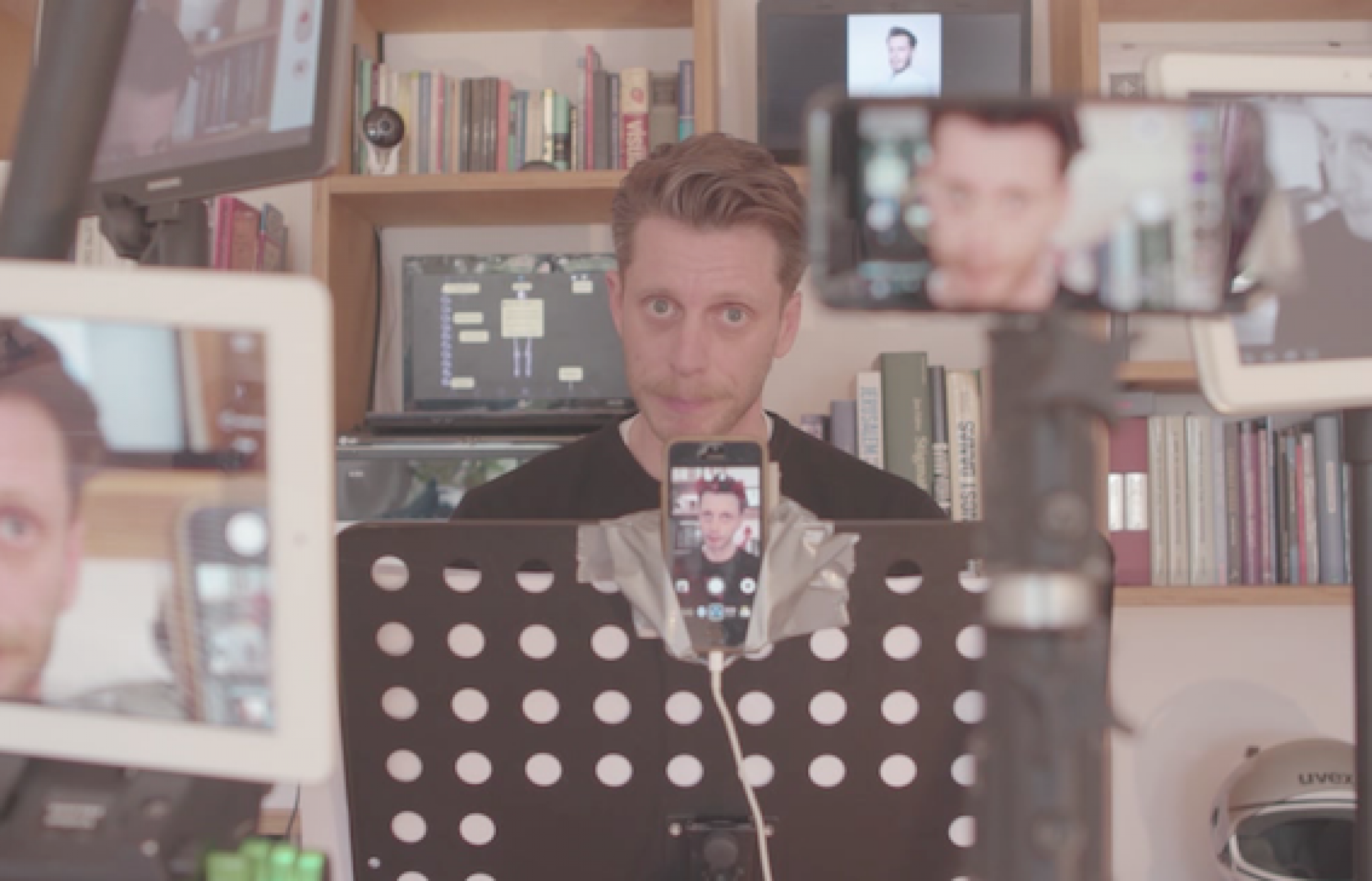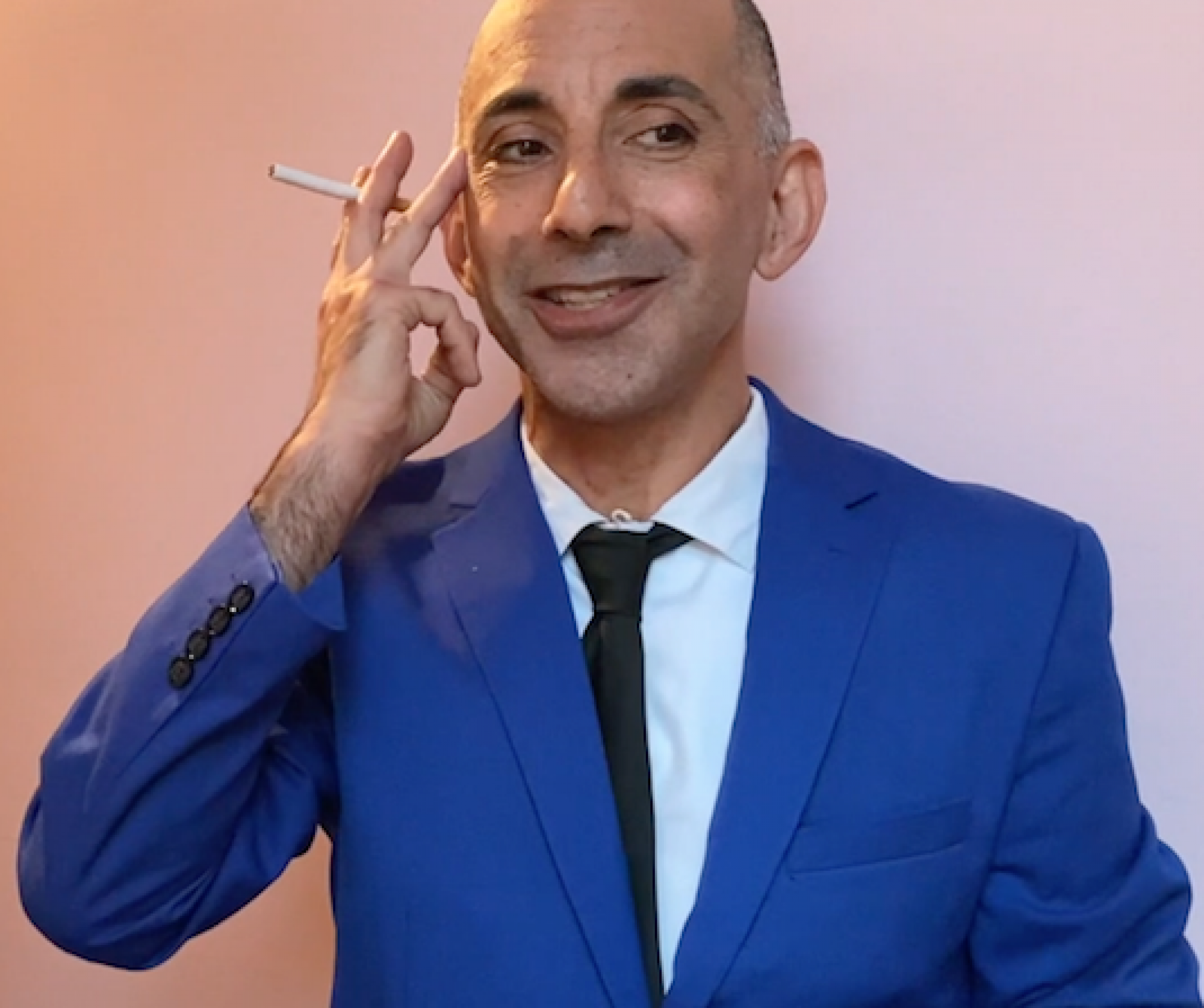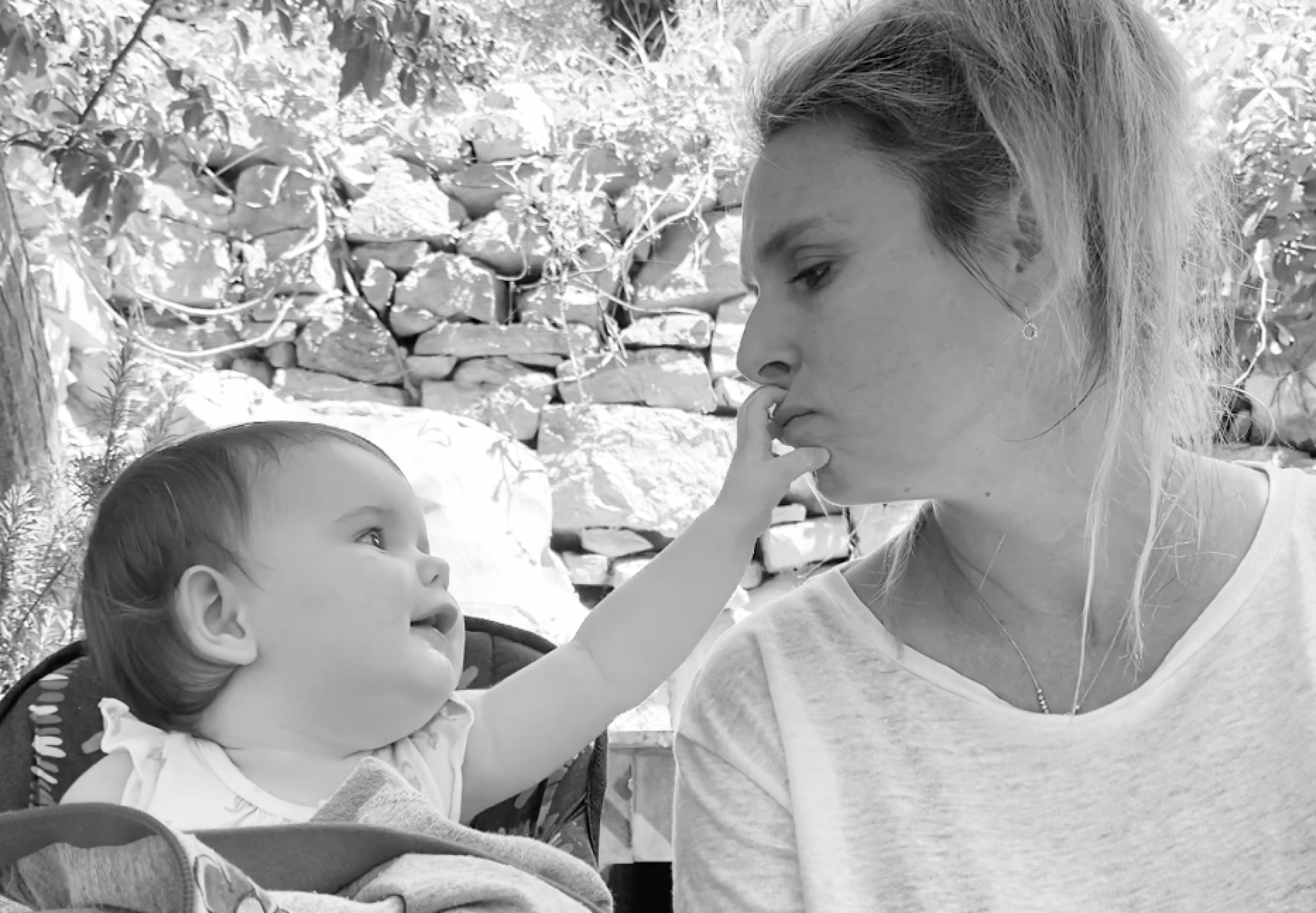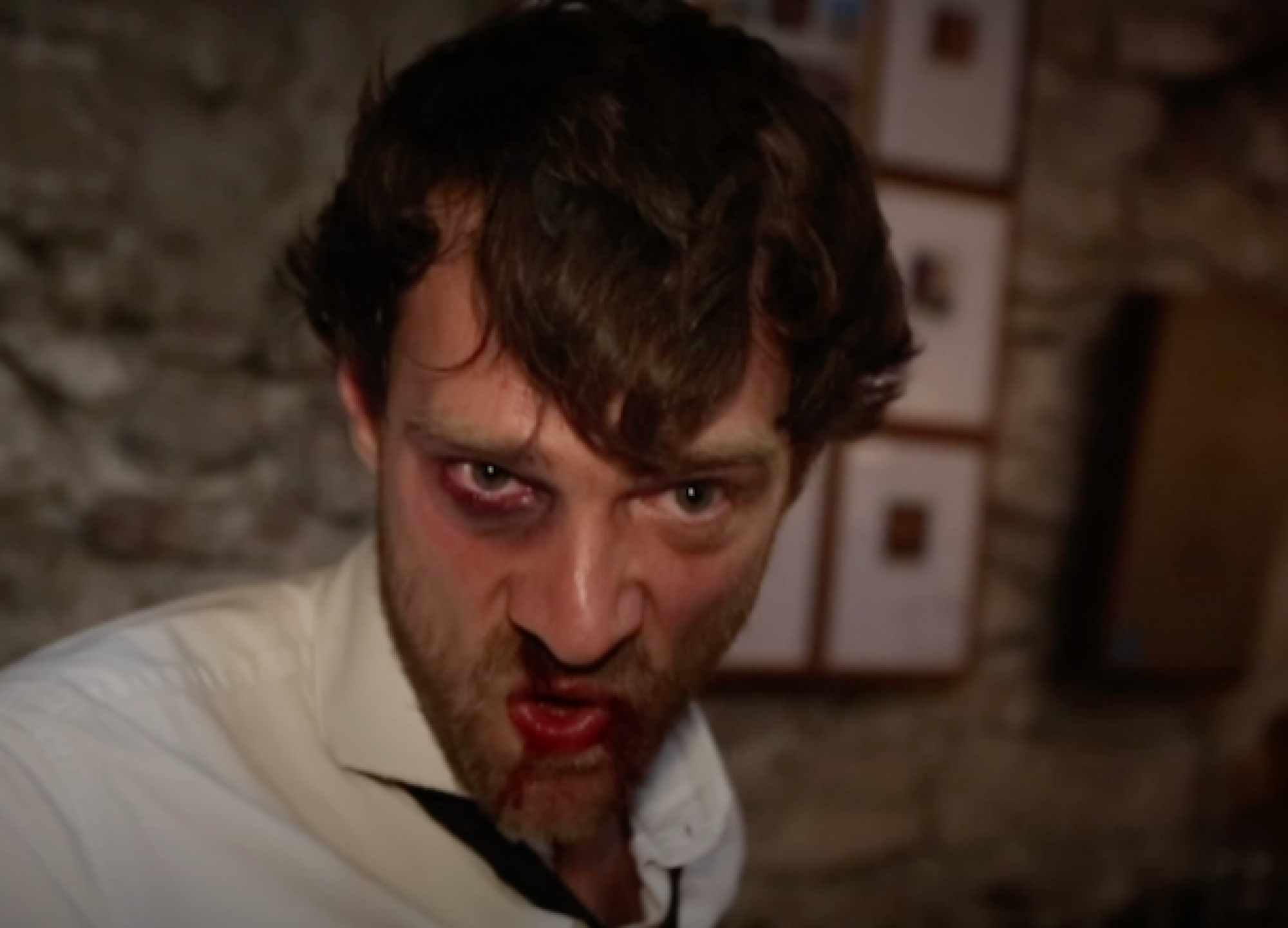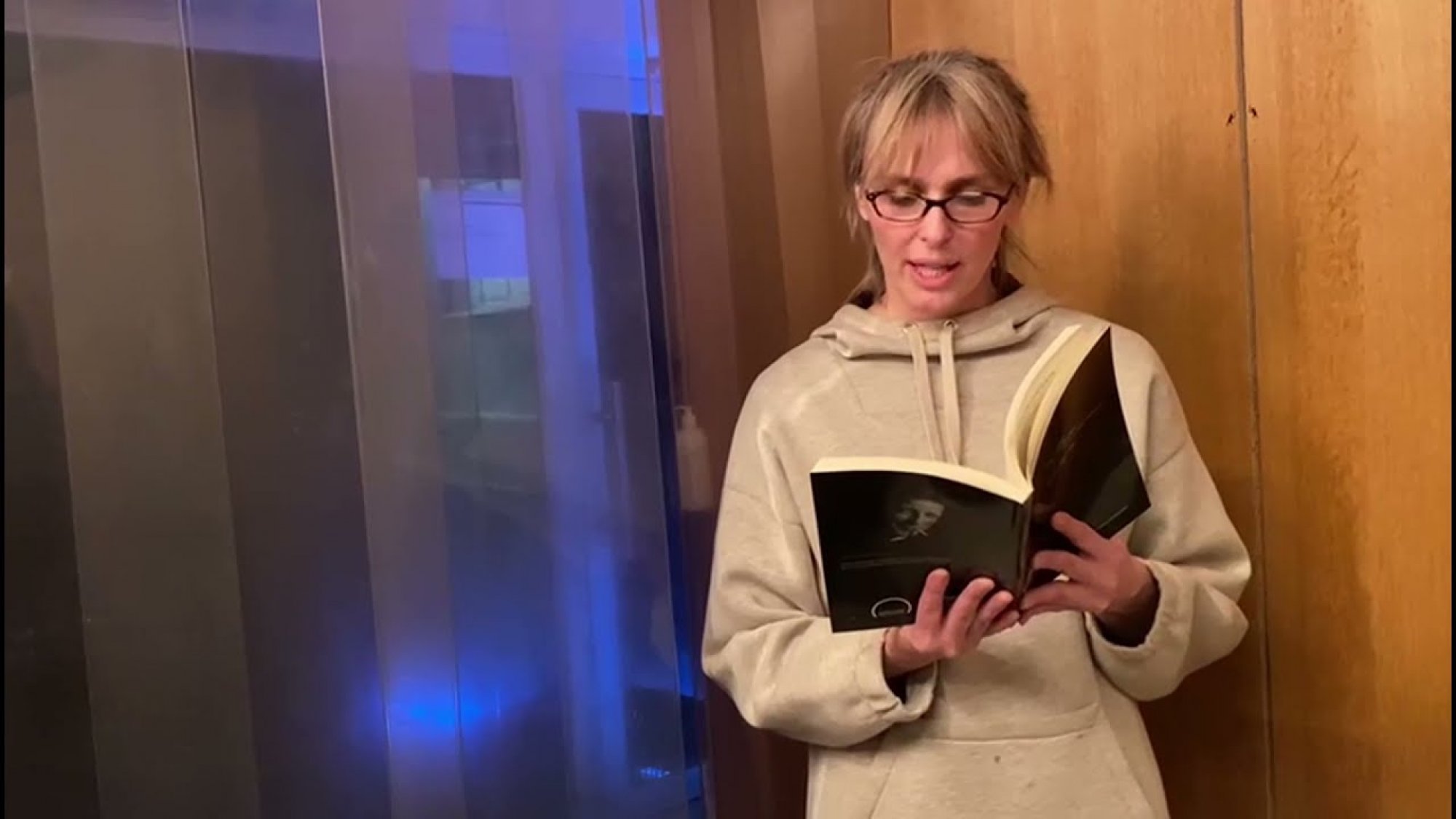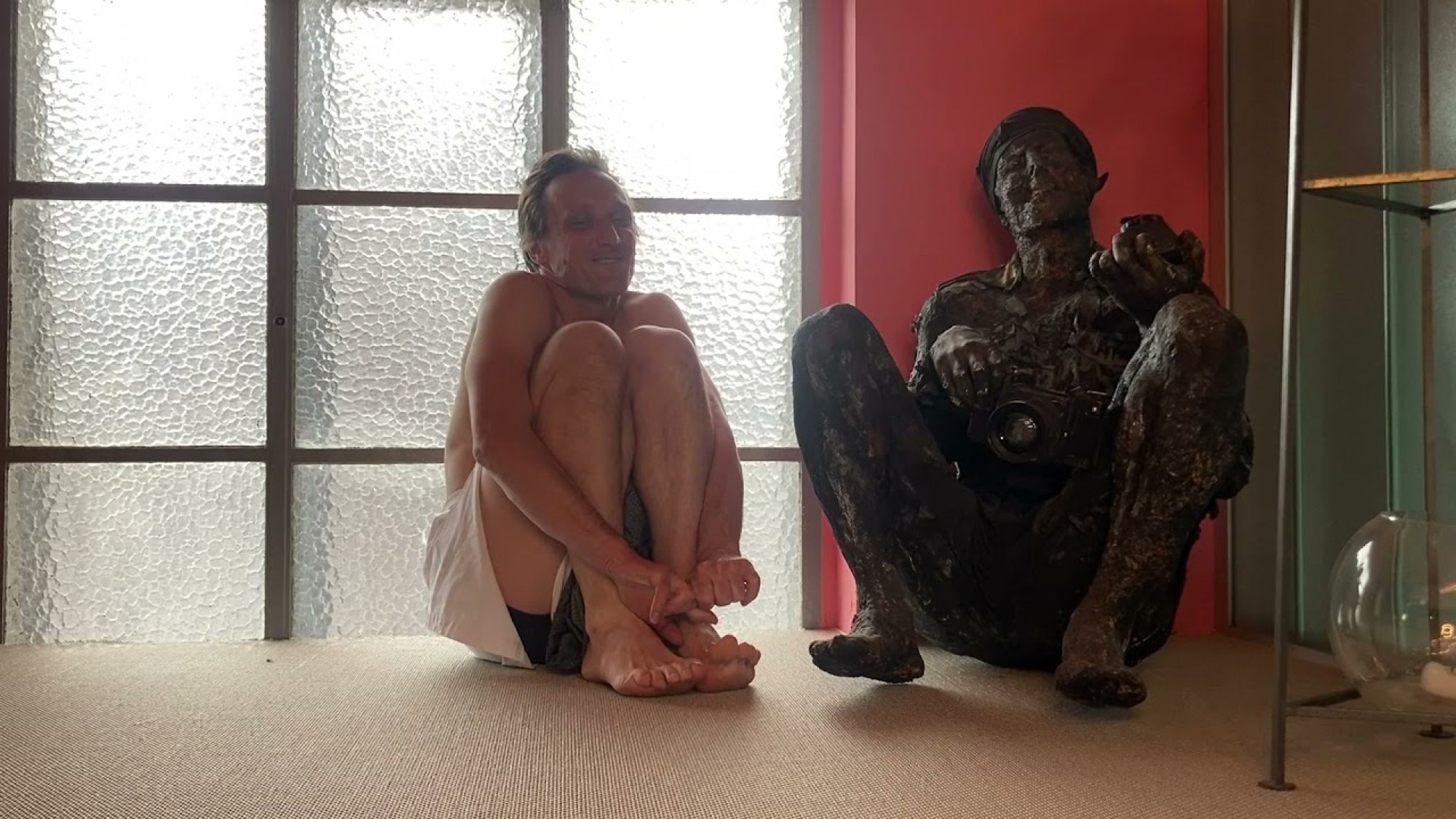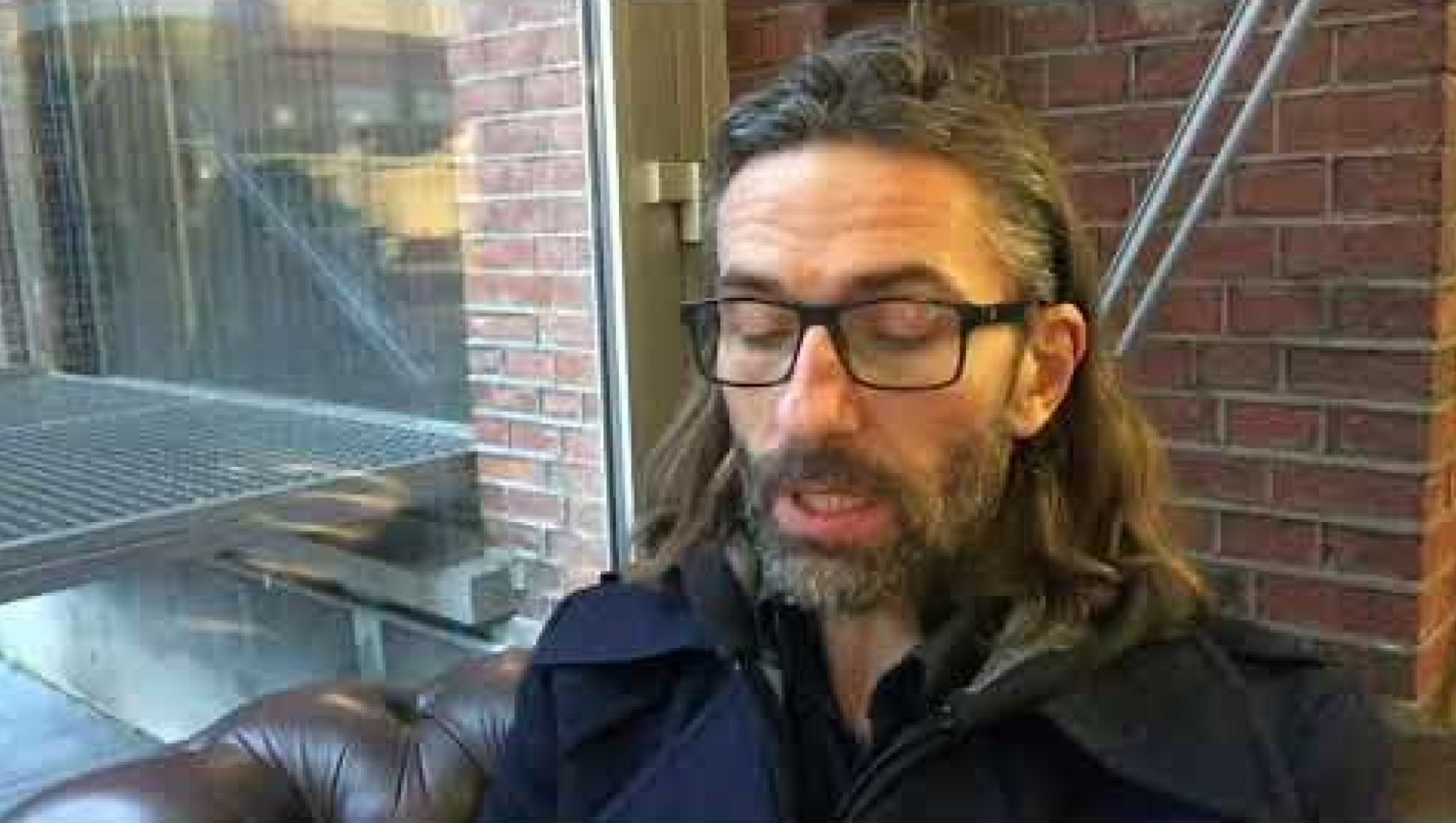
If you can't come to us, we'll come to you! That is the thought that inspired the international colorful group of performers of Troubleyn/Jan Fabre to read for you, in their mother tongue, from their homes in quarantine, a theatre text or a fragment of a theatre text, written by Jan Fabre. The readings were staged, interpreted and visualized by the performers themselves.
Italian actress IRENE URCIUOLI reads in her mother tongue a fragment of ‘Simon, gangster of art’. The theatre text, written by Jan Fabre in 2011, has yet to be performed on stage. The monologue details ‘Simeon the Stylite’ and his criminal plan to restore the healing and spiritual power of beauty.

Performer ANDREY FESKOV recites, in Russian, a fragment of the theatre monologue 'Body on the wall'. The text explores the relationship between a dancer and a photographer: a metaphor for the relationship between a performer and the public. The central idea; that we become only aware of our body through the gaze of the other.
Video filmed at the beautiful The State Hermitage museum. SaintPetersburg, Russia. Artwork Featured at the end of the clip, Jan Fabre's ‘Stupidity is Founded on Mortality’ (2016) part of the permanent collection.

Performer ANNY CZUPPER graces us with a reading from the monologue; THE KING OF PLAGIARISM (1998-2005). In the monologue, Fabre explores the notion that copying and repetition are necessary conditions for evolution, minimising the importance of originality and authenticity in science, the arts and philosophy. Artwork in video: Jan Fabre’s ‘Table for Knights of Despair’ (Resistance) (2007)

The amazing Italian actress SONIA BERGAMASCO graces us with a fragment of 'We Need Heroes Now!' (Jan Fabre, 2010). Inspired by a group of people photographed at Ground Zero, the day after 9/11, holding a banner aloft reading ‘We need heroes now’ - Fabre examines our yearning for a hero and by whose standards are heroes defined.

Russian performer ALEXANDER MOLOCHNIKOV recites a fragment of ‘The Reincarnation Of God’ (1976) in his mother tongue. The character Jean has an ongoing inner monologue with his brother Emile, who died prematurely. It is a story full of conflicting emotions of sadness, jealousy, pain, fear, regret.

Irish performer CONOR DOHERTY reads a fragment from ‘I am blood' (2001). Jan Fabre wrote this text as a ‘medieval fairy tale’ exploring physical and mental wounds that we still carry with us since the Middle Ages. The precious bodily liquid 'blood' is the centralising force of this text. Artwork seen in video (Background): ‘Bloodstains’ (2007) by Luc Tuymans.

PIETRO QUADRINO reads, in Italian, a fragment from A PERFECTLY NORMAL WOMAN (1995): the text originally written for performer Els Deceukelier. A fascinating story about the dark place that is hidden deep inside each of us. A dialogue between ‘man’ and ‘woman’ takes place in the mind of one woman. Lilith, devoting herself to nature and mysticism, wants to free herself from her body, to explore her imagination to the farthest end.

MARKO MANDIC reads, in Slovenian, a fragment from THE KING OF PLAGIARISM (1996), the text exploring the notion that copying and repetition are necessary conditions for evolution in science, the arts and philosophy.
Artwork in Video: ‘Death Valley’ (2008) by Wim Vandekeybus

CEDRIC CHARRON reads in French, Chapter 4 from Jan Fabre’s theatre monologue BODY ON THE WALL.

Russian performer ANDREJ FESKOV recites a fragment of ‘The Reincarnation Of God’ (1976) in his mother tongue as he walks the streets of Moscow. The character Jean has an ongoing inner monologue with his brother Emile, who died prematurely. It is a story full of conflicting emotions of sadness, jealousy, pain, fear, regret.
Italian actress IRENE URCIUOLI reads in her mother tongue 'Who shall speak my thought'. Jan Fabre wrote this monologue in 1980 for someone with sensitive ears and sensitive eyes. The character, a hypersensitive person, is obsessed with the sounds that surround him and as such drives himself crazy. The text
Artwork seen in video (Background): 'Suonano alla porta / Who's Ringing at the Door?' (2007) by Bruna Esposito.

Croatian performer IVANA JOZIC reads I' am blood' (2001). Jan Fabre wrote this text as a ‘medieval fairy tale’ exploring physical and mental wounds that we still carry with us since the Middle-Ages. The precious bodily liquid 'blood' is the centralising force of this text. The text, which sounds like a litany, is partly written in Latin and contains references to the works of the twelfth-century mystic, Hildegard von Bingen.

STELLA HÖTTLER reads, in German, ‘Poem 7’ from Jan Fabre’s poetic texts about dreaming and myths; ‘REMNANTS’ (2014). Jan Fabre’s theatre texts are published in German by Fisher Verlag.
Artwork in Video: ‘Death Valley’ (2008) by Wim Vandekeybus

The amazing Italian actress Sonia Bergamasco graces us with ‘Poem 3’ from Jan Fabre’s ‘REMNANTS’ (2014): poetic texts in which Fabre invites us to enter the domain of dreams and myths. Jan Fabre wrote these texts about dreaming and insomnia for the historical performance 'Mount Olympus - To glorify the cult of tragedy (2015). The text was published in Italian by Editoria&Spettacolo in a translation by Franco Paris.

CÉDRIC CHARRON reads in French, a fragment from Jan Fabre's theatre text 'Le Marchand de Sel et la Mouche/ The Salt Seller and the Fly’ (1998). Originally written for the actors Els Deceukelier and Jan Decleir, the text explores a playful conversation between a Salt Seller and a Fly, an allegorical fairy tale about the night. The salt seller is a metaphor for the artist and refers to Marcel Duchamp, aka 'Le Marchand du sel'. Through the character's conversation, two differing world views collide – for the salt seller, the night is a time to be productive, claiming "Everything of value requires sacrifice". On the other hand, the fly is an individual who seizes the day without being tormented by missions. As such, the text explores the ideas of what it is to compromise on a dream and question one's identity – in the end, the concept of 'metamorphosis' is the central paradigm. Artwork in Video: 'Lights and Colours' by Belgian artist Erik Van de Mert.

Jan Fabre dedicated the play to his deceased parents, Edmond Fabre and Helena Troubleyn. SYLVIA CAMARDA reads, in French, ‘Chapter VII’ of the text, portraying multiple characters including Doctor/Philosopher, Thanatopractor, Coffin-Maker, and the main protagonist a ‘Butterfly that tries to make the dead laugh’ by telling jokes. The smile is, according to the butterfly, an ideal remedy against death. As such the characters are brought together in the exploration of life and death, the moment of metamorphosis, a lively feast in honour of the dead. REQUIEM FOR A METAMORPHOSIS - pays tribute to all frontline workers caring for loved ones and patients, in particular to those that are faced with death daily.

CONOR THOMAS DOHERTY reads a fragment of ANGEL OF DEATH (1996). In this text, Jan Fabre, inspired by the androgynous figure of the American artist Andy Warhol, explores several ideas relating to authenticity and the immortality of icons. The character lives a dual identity, examining the relationship between the artist and the outside world, torn between the conflicting desires – the desire for recognition and the desire for anonymity.
About the Artist: Conor Thomas Doherty is a performance artist from Ireland. Trained as a dancer in the Netherlands, he joined Troubleyn/Jan Fabre in 2016. Performances include Mount Olympus – To glorify the cult of tragedy, Belgian rules/ Belgium rules and now, The Fluid Force of Love. Conor is also working internationally with theatre and dance companies such as Angelica Liddell, United Cowboys and Irish Modern Dance Theatre.

Exactly one year ago ANNY CZUPPER took up the challenge and presented the very first Corona Reading. The project, born in the time of corona, aimed at each performer (digitally) sharing their own interpretation, language and passion for theatre. Today, over fifty Corona Readings later, Anny once again graces us with a reading, this time from the monologue THE KING OF PLAGIARISM (1998-2005). In the monologue, Fabre explores the notion that copying and repetition are necessary conditions for evolution, minimising the importance of originality and authenticity in science, the arts and philosophy.
- Artwork in video: Klopper (2007) by Belgian artist Wim Delvoye.
About the artist: Anny Czupper joined Troubleyn/Jan Fabre in 2000 with the performance As long as the world needs a warrior’s soul. She has gone on to perform in multiple productions including Je suis sang (2001), Histoire des larmes (2005) for Festival d’Avignon, Cour d’honneur and Mount Olympus – To glorify the cult of tragedy (2015). Aside from her acting career Anny also works with the company as a voice-coach and French language coach.

PIETRO QUADRINO reads, in Italian, a poem excerpt from Jan Fabre’s REMNANTS (2014). With a guest appearance of Matteo Sedda.
"We have myths just like we have dreams.
Despite all the differences, dreams and myths have one thing in common:
they are written in the same forgotten language.
By learning this fantastic forgotten language again,
we encounter the most important source of wisdom: bewilderment.
A bringer of insights about ourselves to ourselves
This universal forgotten language has a different logic than the conventional language we use when we are awake.
When we are asleep, everything changes and we awake into another form of existence.
We dream and we direct our own dreams.”
- Jan Fabre, Remnants, 2014 (published in Italy by Editoria & Spettacolo.)
About the artist: Italian born actor, Pietro Quadrino’s passion for theatre has led him work in Italy, Spain, France and Belgium with some of the most well-known European artists and theatre companies including Théâtre du Soleil, Angelica Liddel, Carlo Boso, Alex Rigola and Jan Fabre. Pietro joined Troubleyn in 2012 and has regularly worked with the company since then. Pietro is currently on stage in Fabre's new creation The fluid force of love.

IRENE URCIUOLI reads an excerpt, in Italian, from I AM BLOOD. Jan Fabre wrote this text in 2001 as a ‘medieval fairy tale’ exploring physical and mental wounds that we still carry with us since the Middle-Ages. Fabre stating: “The text of I am blood asks us to return to our bodies by making them liquid. Because our body has the greatest memory, the most power. And by leaving behind the shell that is the body, you can no longer have wounds.” The text, which sounds like a litany, is partly written in Latin and contains references to the works of the twelfth-century mystic, Hildegard von Bingen.
Artwork seen in video (background): Spirit Cooking by Marina Abramovic.
About the Artist: Italian actress Irene Urciuoli joined the company Troubleyn/Jan Fabre in 2018 with the performance Belgian rules/Belgium rules and Mount Olympus – To glorify the cult of tragedy in New York in November 2018. Irene is currently on stage in Fabre's new creation The fluid force of love.

ANNABELLE CHAMBON reads an excerpt, in French, from WHO SHALL SPEAK MY THOUGHT? Jan Fabre wrote this monologue in 1980 for someone with sensitive ears and sensitive eyes. The character drives himself crazy with his spinning thoughts, a feeling that you might recognize in these bizarre times where social contact is often limited to online meetings.
Artwork in video: '2060 Cédric' by Belgian artist Tjen Meylemans.
About the artist: French performer, dancer and actress Annabelle Chambon joined Troubleyn/Jan Fabre in 2000 with the performance As long as the world needs a warrior’s soul and since then has been an indispensable part of the company. She has performed in a specially created dance solo work Preparatio Mortis (2005) and is a senior teacher of the Jan Fabre Teaching Group. Annabelle Chambon is currently on stage in Fabre's new creation The fluid force of love.

MATTEO SEDDA reads an excerpt, in Italian, from DRUGS KEPT ME ALIVE. Jan Fabre wrote this text in 2011, based on performer Antony Rizzi’s personal story and his courageous dance with HIV-seropositivity, the virus humanity had to learn to live with since the mid-eighties. Matteo Sedda found out a few years ago that he was HIV-seropositive. While at first, he found it difficult to talk about, he created in 2018 in Troubleyn/Laboratorium POZ! a performance in which the malaise of a young HIV-positive initiates a path towards the rediscovery of light through a personal, autobiographical experience.
About the artist: Dancer, performer and choreographer Matteo Sedda has been collaborating since 2014 with Troubleyn/Jan Fabre for the performance Mount Olympus – To glorify the cult of tragedy (2015) and the solo The generosity of Dorcas (2018). Matteo will also be on stage in Fabre's upcoming creation The fluid force of love.

IVANA JOZIC reads I AM A MISTAKE (Jan Fabre, 1988). The blunt confession 'I am a mistake' is repeated like a mantra, a metaphor for what it is to be an artist in relation to the outside world, a protest against conforming, exposing every human beings' shortcomings. The text explores smoking, seen as an act of individuality against the established social order, despite negative health impacts still pertains to a sense of aesthetic and sensual associations.
About the artist: Ivana Jozic studied dance at the School for Classical Ballet in Zagreb & London Contemporary Dance School and acting in Drama Studio London. In 2003 she joined Troubleyn/Jan Fabre as a performer in Je suis sang. Since then she has performed in numerous works, including Fabre's solo Angel of Death (2003) (on tour for four years), in a specially created solo work Another Sleepy, Dusty, Delta Day (2008) and Pierre Coulibeuf's Doctor Fabre will cure you (2013). Ivana will also be on stage in Fabre's upcoming creation The fluid force of love.

PIETRO QUADRINO reads, in Italian, a fragment from REMNANTS: poetic texts in which Fabre invites us to enter the domain of dreams and myths "What’s the most important state? To be awake or to sleep?". Jan Fabre wrote these texts about dreaming and insomnia for the historical performance Mount Olympus - To glorify the cult of tragedy (2015). About the artist: Italian born actor, Pietro Quadrino’s passion for theatre has led him work in Italy, Spain, France and Belgium with some of the most well-known European artists and theatre companies including Théâtre du Soleil, Angelica Liddel, Carlo Boso, Alex Rigola and Jan Fabre. Pietro joined Troubleyn in 2012 and has regularly worked with the company since then. He has gone on to create the literary movement of The Pyropoets based in Brussels. Pietro will also be on stage in Fabre’s upcoming creation The fluid force of love.

STELLA HÖTTLER reads, in German, a fragment from THE KING OF PLAGIARISM (Jan Fabre, 2005). In this monologue, Fabre develops the notion that ‘copying’ and ‘repetition’ are necessary conditions for evolution, as such he minimises the importance of originality and authenticity in science, the arts and philosophy.
About the artist : Stella Höttler studied classical ballet at the University for Music and Performing Arts in Mannheim, Germany, where she was granted a scholarship by the German Academic Scholarship Foundation. After her studies, she joined Troubleyn/Jan Fabre as a performer in Mount Olympus (2015), Belgian Rules/Belgium Rules (2017) and in a specially created solo work Resurrexit Cassandra (2019). Stella will also be on stage in Fabre’s upcoming creation The fluid force of love.

CEDRIC CHARRON reads, in French, a fragment (Room 11) from Jan Fabre’s theatre monologue BODY ON THE WALL (1996). The text explores the relationship between a male performer and a female photographer: a metaphor for the relationship between a performer and the public. The central idea of the work; that we become only aware of our body through the gaze of the other.
About the artist: French dancer and actor, Cédric Charron, joined Troubleyn/Jan Fabre in 2000, performing in (almost) every group performance since. In 2014 Jan Fabre created the solo work Attends Attends Attends ,… pour mon père for and with Charron. Since its inception, he has been a part of the Jan Fabre Teaching Group, training new generations of performers. Cédric will also be on stage in Fabre’s upcoming creation The fluid force of love.

IOANNA MOULIAKOU reads in Greek THE SERVANT OF BEAUTY (Jan Fabre, 2004-2009). Speaking is a puppeteer who strives to become invisible in order to put ‘beauty’ in the spotlight. The Servant of Beauty is the third part of Jan Fabre's theatre trilogy, along with The Emperor of Loss and The King of Plagiarism, that explores concepts of the artist, beauty and ‘the lie of the imagination'.
About the Artist: The Greek actress, director and linguist Ioanna Mouliakou main interest is physical theatre. This led her to the Jan Fabre Teaching Group to practice Fabre’s Guidelines for the performer of the 21st century - From Act to Acting.

ANN EYSERMANS reads, in Dutch, excerpts from REQUIEM FOR A METAMORPHOSE (Jan Fabre, 2006). Inspired by a selection of short reflections from the text on life, death, and metamorphosis, Ann accompanies her reading musically by improvising on the harp. The text pays tribute to all frontline workers caring for loved ones and clients, in particular to those that are faced with death daily.
Film and editing: Istvan Lee-Össy and Ann Eysermans in the ChampdAction/Studio. Requiem for a metamorphose (Jan Fabre, 2006) was published in Dutch by Bezige Bij.
About the artist: Ann Eysermans is a musician (double bass and harp), performer, and composer. She is an artist in residence with ChampdAction and has an unbridled fascination with trains - as seen in her Ph.D.‘ P-TRAINS (Astrin Phosphora)’ comprising of tape compositions with train sounds, train poems, images, and videos. Having performed in Requiem fur eine Metamorphose, (2007, by Troubleyn/Jan Fabre and ChampdAction), Ann also performed in the film that Chantal Akerman created for the production I am a mistake (2008 / by Troubleyn / Jan Fabre.)

IRENE URCIUOLI reads, in Italian, WAIT, WAIT, WAIT... (For my father). The text was originally written by Jan Fabre in 2014, as a specially created solo work for Troubleyn/Jan Fabre performer Cédric Charron. In the text, the figure of the son has an imaginary exchange of thoughts with his father. The son goes on to reveal himself as Charon, the ferryman (based on Greek/Roman mythology) that prepares the father for the last passage.
About the artist: Irene Urciuoli is an Italian actress. She joined Troubleyn/Jan Fabre in 2018 with the performance Belgian rules/Belgium rules and Mount Olympus – To glorify the cult of tragedy.

DIONISIS DENNIS MAKRIS reads, in Greek, WE NEED HEROES NOW! (Jan Fabre, 2010).
Inspired by a group of people photographed at Ground Zero, the day after the history-altering events of 9/11, holding a banner aloft with the inscription ‘We need heroes now’ - Fabre examines our yearning for a hero and by whose standards are heroes defined.
About the actor: The Greek performer Dionisis Dennis Makris first joined the Troubleyn Company in 2012 for the re-enactment of The power of theatrical madness. A part of the theatrical group 'Little Things Orchestra' he took on performance roles including Hamlet and Oedipus Tyrannus. An actor for the National Theater of Greece, he has participated in the Ant1 TV series, Tamam and the Athens & Epidaurus Festival.

TOM TIEST selected fragments from ANOTHER SLEEPY DUSTY DELTA DAY (Jan Fabre, 2008) for his cinematic and musical contribution to the ‘Corona Readings’. Based on the legendary country hit ‘Ode to Billie Joe’ by Bobby Gentry, the theatre play is in the form of a letter from a man to his beloved. The outcome is a truly personal text, that tells a story about loving and letting go, about jumping into the unknown infinity. Actress Annika Serong reads.
About the artist: Tom Tiest is a guitarist, composer and producer. Having worked with Jan Fabre as a performer/musician in Requiem fur eine Metamorphose, Tom also composed the music for Another sleepy dusty delta day- a solo for Ivana Jozic, and Attends, attends, attends … (pour mon père) - a solo for Cédric Charron.

GORAN NAVOJEC reads, in Croatian, I AM A MISTAKE (Jan Fabre, 1988).
The blunt confession ‘I am a mistake’ is repeated like a mantra, a metaphor for what it is to be an artist, a protest. A protest against reality and its laws, against matters of fact and conforming to the ‘status quo’.
About the actor: Goran Navojec is a famous Croatian actor and musician. In his three decades long career, he starred in numerous films, had prominent roles on television and on stage. He has worked for various American and British stage and screen productions, including Mission Impossible (2011). For the body of his work, Navojec has received critical acclaim and numerous awards. In 2009 he toured the world with the performance Orgy of Tolerance by Jan Fabre.

ANNABELLE CHAMBON reads ÉTANT DONNÉS (Jan Fabre, 2004) - published in France by L’Arche Editeur.
Jan Fabre was inspired by Marcel Duchamp’s last work Étant donnés: 1. La chute d’eau, 2. Le gaz d’éclairage (Given: 1. The Waterfall, 2. The Illuminating Gas), which Duchamp constructed in total secrecy over a twenty-year period. Looking through a small peephole the unsuspecting viewer is confronted with a realistically constructed simulacrum of a naked woman lying spread-eagle on a bed of dead twigs and fallen leaves, her left arm holds aloft a gas lamp, behind glows a landscape of colorful trees and a waterfall. The work forces the viewer into a voyeuristic role and is the result of Marcel Duchamp’s reflection on performing arts.
Fabre’s theatre text Etant donnés (2004) comments and radicalizes Duchamp’s thought by developing a dialogue between a woman and her vagina. While the woman nurtures illusions of seduction and power, her vagina always reminds her of passion and sexual desire. It delivers a strong metaphor of the spectacle-society.
About the artist: Annabelle Chambon (performer, dancer, actress) - since performing in As long as the world needs a warrior’s soul (2000) - is an indispensable part of the ensemble Troubleyn/Jan Fabre. She is also a senior teacher of the Jan Fabre Teaching Group.

NIKOLAUS BARTON reads, in German, BODY ON THE WALL. The central idea of the play is that we become only aware of our body through the gaze of the other. Jan Fabre wrote the text, based on interviews with the artists ORLAN, Rob Scholte and Wim Vandekeybus, in 1996.
The reading was filmed by Claudia Lomoschitz.
About the artist: Nikolaus Barton is an Austrian actor, author and (film)director. In 2013 he performed the role of Richard Wagner in Fabre’s Tragedy of a friendship. Nikolaus is a member of the ensemble of the Theater in der Josefstadt in Vienna. He just finished shooting two projects for Austrian TV and the short movie Inertia for the Filmakademie Vienna.

ALEXANDER MOLOCHNIKOV chose a rooftop overlooking Moscow and the Kremlin to read some fragments, in Russian, of I AM A MISTAKE. Jan Fabre wrote this artist manifesto as a homage to Luis Buñuel in 1988.
The theatre plays by Jan Fabre have been published in Russia by Electro Theater.
About the artist: Alexander is a famous multi-awarded Russian stage and film director and actor. He is one of the two talented actors who perform The Night Writer, Fabre’s first repertoire performance at the Bolshoï Drama Theater in Saint Petersburg.

CHIARASTELLA SORRENTINO reads, in Italian, WE NEED HEROES NOW (Jan Fabre, 2010).The reading is a tribute to all the health care workers, the real heroes in the fight against Corona. The text was published in Italian by Editoria&Spettacolo in a translation by Franco Paris.
About the artist: Chiarastella Sorrentino (born in Naples in 1995) is an Italian actress from the National Theater of Genoa. She met Jan Fabre for the first time in the Jan Fabre Teaching Group in November 2019 at the Troubleyn/Laboratorium.

DIMITRI BRUSSELMANS reads in Dutch fragments from DRUGS KEPT ME ALIVE (2011). Jan Fabre wrote the text for Antony Rizzi whose story inspired him. It tells about a dancer's courageous duet with HIV-seropositivity, the virus humanity had to learn to live with since the mid-Eighties. This sentence says it all: "Am I sick or am I an incurable lover of life?"
About the artist: Dimitri Brusselmans collaborated as a performer and musician on the Troubleyn/Jan Fabre performances Je suis sang (2005), Histoire des larmes (2005) and Requiem fur Eine Metamorphose (2007). He also composed the music for the performance Drugs kept me alive (2012). Before and after the classical studies at the Royal Flemish Music Conservatory, he played with rock-elector and classical orchestras such as The Wineguns, Boenox, Monky Pussy, I Fiamminghi or more recerntly Fluo Zwart.

IOANNA MOULIAKOU reads in Greek fragment 34 from REMNANTS. Jan Fabre wrote these poetic texts about dreaming and insomnia for the historical performance Mount Olympus (2015). Jan Fabre's theatre plays are published in Greek by NISSOS.
About the Artist: The Greek actress, director and linguist Ioanna Mouliakou is mainly interested in physical theatre. This led her to the Jan Fabre Teaching Group to practice Fabre's Guidelines for the performer of the 21st century, From Act to Acting.

CEDRIC CHARRON reads in French the monologue WAIT, WAIT, WAIT… (for my father). (Jan Fabre, 2014). It is a homage to the father of Cédric and to their family name Charron. In Attends, attends, attends... (pour mon père), the son has an imaginary exchange of thoughts with his father. The son reveals himself as Charon, the ferryman that prepares the father for the last passage. Jan Fabre and Cédric Charron (dancer, performer, actor) have been working closely since As long as the world needs a warrior's soul (2000). Jan Fabre's theatre plays are published in France by L’Arche Editeur.

IVANA JOZIC reads ANOTHER SLEEPY DUSTY DELTA DAY. Jan Fabre wrote this text for her in 2008, inspired by the legendary 1967 country hit Ode to Billy Joe by Bobby Gentry. Another sleepy dusty delta day is a love letter. A story about loving and letting go, about jumping into the endless unknown. Ivana Jozic (performer, dancer, actress) is a permanent member of Troubleyn since 2003. She is also a senior teacher of the Jan Fabre Teaching Group. The reading was filmed by Milan Kovacevic.
Jan Fabre's theatre plays are published in English by the Martin E. Segal Theatre Center in New York.

PHIL GRIFFIN reads WE NEED HEROES NOW (Jan Fabre, 2010). On September 12, 2001, a group of people in front of Ground Zero in New York, were photographed with a banner that read WE NEED HEROES NOW! The reading is a tribute to all the health care workers who throw themselves with body, heart and soul into the fight against Corona.
In 1987 British artist Phil Griffin was the first male dancer of Troubleyn (Das Glas im Kopf wird vom Glas, The Dance Sections). Almost 30 years later, he was invited by Jan Fabre to witness the creation of the Mount Olympus project as artist in residence at Troubleyn/Laboratorium. The result was the exhibition Surrender comprising 40 photos and one unique feature-length art documentary.

STELLA HÖTTLER, performer and dancer at Troubleyn since 2014, reads in German I AM BLOOD. A medieval fairytale (Jan Fabre, 2001). The play revolves round the notion that little has changed since the so-called ‘dark’ Middle Ages. There has been no true evolution, because, in his urges and impulses, man still displays great aggression, in which he is not essentially different from the animals, and also still displays a systematic bloodthirstiness, in which he is essentially different from the animals.
Jan Fabre’s theatre texts are published in Germany by Fischer Verlag.

MATTEO SEDDA, performer and dancer at Troubleyn since 2014, reads in Italian some extraits of REMNANTS. Jan Fabre wrote these poetic texts about dreaming and insomnia for the historical performance Mount Olympus (2015).
Residui' is published in Italian by Editoria & Spettacolo in a translation of Franco Paris.

IRENE URCIUOLI reads in Italian ANGEL OF DEATH (1996). The text was inspired by the works and the life of the American pop-art artist Andy Warhol. The subtitle reads ‘a monologue for a man, a woman or a hermaphrodite’. This androgynous ambiguity is the heart of the text.
The theater texts by Jan Fabre are published in Italy by Editoria & Spettacolo in a translation by Franco Paris.

GUSTAV KOENIGS, actor and performer at Troubleyn since 2013, reads in German I AM A MISTAKE (1988). “I am a mistake because I have too much desire more compelling even than hunger.” And the character knows that he has to pay a price for this: that of gradual self-destruction. The film was created by KAKVERSUM, a collective of Gustav Koenigs, Karl Anton Koenigs, Julia Maria Primus and Matthias Grüner.
Jan Fabre’s theatre texts are published in Germany by Fischer Verlag.

LORE BORREMANS reads in Dutch excerpts from REMNANTS (2014.). Jan Fabre wrote these poetic texts about dreaming and insomnia for the historical performance Mount Olympus (2015). Lore Borremans has been active with Troubleyn/ Jan Fabre since 2014 as a dancer, performer and assistant director. Remnants was published in Dutch by De Bezige Bij.

TOBIAS LANGE reads in German THE REINCARNATION OF GOD (1976). The character Jean has an ongoing inner monologue with his brother Emile, who died prematurely. It is a story full of conflicting emotions of sadness, jealousy, pain, fear, regret ...Tobias Lange performed the character of Jean in the German performance Die Reinkarnation Gottes that Jan Fabre created for Theater Am Turm in Frankfurt.
Jan Fabre's theatre texts are published in Germany by Fischer Verlag

GIULIA PERELLI reads in Italian I AM A MISTAKE (1988). The blunt confession ‘I am a mistake’ is repeated like a mantra, as a metaphor for an artist, a metaphor for protest. Protest against reality and its laws, against matters of fact and their conformism. It comes as no surprise that this piece is dedicated to the subversive film-maker Luis Buñuel. The text is published in Italian by Editoria & Spettacolo.

PIETRO QUADRINO, performer at Troubleyn since 2012, reads in French some excerpts from the monologue THE EMPEROR OF LOSS (1994). Jan Fabre dedicated this text to Tommy Cooper. This British comedian mastered the art of making his magic tricks fail in an inimitable way. The play is an ode to the beauty of the failure and the art of never giving up. Because one can always start over, again, from the start. Jan Fabre’s theatre texts are published in French by L’Arche Editeur.

IVANA JOZIC reads, together with her daughter Elizabeta, in English, A TRIBE, THAT’S ME. It is Jan Fabre’s poetic vision on the work of theater thinker and visionary Antonin Artaud. Artaud went searching for a secret ritual among Indian tribes to find the divine within himself. Jan Fabre’s theatre plays are published by the Martin E. Segal Theatre Center in New York.

KATARINA BISTROVIC-DARVAS reads in Croatian HISTORY OF TEARS (2004). Inspired by Roland Barthes’ question in Fragments d’un discours amoureux, ‘Who will write the history of tears?’, Jan Fabre focuses in this theatre play on the relationship between water and the human body.
Katarina Bistrovic-Darvas performed in Requiem for a metamorphosis (2007), Orgy of tolerance (2009) and Prometheus Landscape II (2011). The reading was filmed by Milan Kovacevic. The text was published in Croatia by ZeKaeM.

ANTONY RIZZI, who is performing at Troubleyn since 1993, reads the monologue I AM A MISTAKE (1988). "I am a mistake because I shape my life and work organically by my judgement, with no conccernt for what one ought to do or say.", this is the frank summary of the world view of the character of the play. Jan Fabre dedicated this manifest to the Spanish surrealist artist Luis Buñuel. Alessandro Costagliola filmed the reading.

ANDREJ FESKOV selected an excerpt from I AM A SACRIFICIAL ANIMAL. Jan Fabre wrote the text in 2015 for the French actress Isabelle Huppert. The main character is a woman who craves for a meaningful existence. With a lot of knowledge and love, she cooks a gastronomic festive meal where she serves an entire beef in seventeen culinary dishes. Andrej Feskov is a renowned Russian theatre- and film actor. He performs with verve The Night Writer, the first repertoire performance of Jan Fabre at the Bolshoi Drama Theater in Saint Petersburg. Andrej filmed the reading in the landscape of his childhood, the Caucasus.

The Italian actress IRENE URCIUOLI reads, from her hometown Milano, LEI ERA ED È, ANCHE (She was and she is, even). Jan Fabre wrote this text in 1975. It was inspired by the artwork The Bride Stripped Bare by Her Bachelors, Even (The Large Glass) from Marcel Duchamp. The play brings art, science, desire and love together in an absurdly and humorous way. The Italian translation by Franco Paris was published by Editoria&Spettacolo in the anthology Jan Fabre TEATRO I.

ANNY CZUPPER reads in French some fragments of the text THE KING OF PLAGIARISM (1998-1005). In this monologue, Fabre develops the notion that copying and repetition are necessary conditions for evolution and he minimises the importance of originality and authenticity in science, the arts and philosophy. Anny Czupper is a member of theTroubleyn company since the mid-nineties, as an actress, as a voice-coach and as a French language coach. The reading was filmed by Philippe Weberman.
Jan Fabre’s theatre texts are published in French by L’Arche Editeur.

STELLA HÖTTLER chose the theatre text ANOTHER SLEEPY DUSTY DELTA DAY (2008) for her reading. Jan Fabre borrowed the title from the legendary 1967 country hit Ode to Billy Joe by Bobby Gentry. He wrote Another sleepy dusty delta day in the form of a love letter. A story about loving and letting go, about jumping into the endless unknown.
Stella Höttler, performer of Troubleyn since 2014, reads this text in the overwhelming nature of the Emmental valley in the heart of Switzerland. Valentin Oppermann filmed her on his phone.

MARIA DAFNEROS reads in English I AM BLOOD (2000). The starting point of this text is the medieval body and the guilt-laden religious thinking that contrasts shrilly with unfettered natural wisdom. Jan Fabre wrote the text for the performance I am blood, a medieval fairy tale he created in 2001 at the invitation of the Festival d’Avignon, for the Cour d’Honneur of the Palais des Papes.
Maria Dafneros, actress of Australian origin, performed in This is theatre like it was to be expected and foreseen (re-enactment 2012) and The power of theatrical madness (re-enactment 2012). She filmed the reading in her home. Audio edit by Panagiotis Stathatos and visual edit by Julie De Clercq.
Jan Fabre's theatre plays are published in English by the Martin E. Segal Theatre Center in New York.

The Croatian actor SVEN JAKIR reads BODY ON THE WALL. Jan Fabre wrote this theatre text in 1996, based on interviews with the artists ORLAN, Rob Scholte and Wim Vandekeybus. The central idea is that we become only aware of our body through the gaze of the other. The reading was filmed and edited by Vanja Vascarac.
Sven performed in The power of theatrical madness (re-enactment 2012) and in Mount Olympus (To glorify the cult of tragedy), two historical masterpieces by Jan Fabre.
The theatre plays by Jan Fabre were published in Croatia by ZeKaeM.

DAG TAELDEMAN and FLORIA LOMME choose a golden cornfield to create a summerly alienating musical improvisation. They took their inspiration from the short monologue HE BELIEVED. Jan Fabre wrote this theatre text, based on the poem Bénédicta, laquelle est la vraie? by Charles Baudelaire, in 1996.
Dag Taeldeman composes music for Troubleyn/Jan Fabre since 2001 (Je suis sang, Orgy of Tolerance, Mount Olympus, a.o). Floria Lomme regularly joins the artistic team as assistant director and assistant dramaturgy since 2013. FLORDALI is their artistic alter ego, together they make surrealistic pop. Their first EP Les 10ièmes, which they created last summer in Paris, will be released soon.

GIULIA PERELLI reads in Italian, SIMON, GANGSTER OF ART, a world premiere! The theatre text, written by Jan Fabre in 2011, hasn't been performed on stage yet. It inspired Giulia to create a short film on Simeon the Stylite and his criminal plan to restore the healing and spiritual power of beauty. The film is a one-woman production by Giulia Perelli, actress and artist. She directed and filmed herself with her phone and did the edit. Giulia performed in This is theatre like it was to be expected and foreseen (re-enactment 2012) and The power of theatrical madness (re-enactment 2012), two legendary masterpieces by Jan Fabre.
Read the entire play of Simon, gangster dell'arte in the book Residui e altri testi published by Editoria & Spettacolo.

The highly-esteemed Slovenian actor SANDI PAVLIN reads an excerpt from Jan Fabre’s theatre text REQUIEM FOR A METAMORPHOSIS (2006). Jan Fabre dedicated the play to his deceased parents, Edmond Fabre and Helena Troubleyn. It is a tribute to all the caretaking people that are professionally bound to death. Sandi Pavlin performs the role of the Doctor-Philosopher, the character that reflects on the meaning of life, of death and metamorphosis. Requiem for a metamorphosis is a mass for the dead, a lively feast in honour of the dead.

MARINKO LES, reads in English, ANGEL OF DEATH (1996). Jan Fabre was inspired for this text by the androgynous figure of the American artist Andy Warhol. The character lives with a dual identity, torn between public fame and anonymity. The actor Marinko Les performed in 2007 in 'Requiem for a metamorphosis'. Jan Fabre created this performance for the famous Felsenreitschule at the invitation of the Salzburger Festspiele.
“I think everybody should like everybody.” - Andy Warhol

PIETRO QUADRINO, performer at Troubleyn since 2012, reads in Italian, A TRIBE, THAT'S ME! It is Jan Fabre’s idiosyncratic poetic vision on the work of theater thinker and visionary Antonin Artaud. Jan Fabre wrote the text in 2004 for Eric Sleichim and the Bl!ndman saxophone quartet for the performance Men in Tribulation.
"La vraie révolution sera mentale ou ne sera pas." - Antonin Artaud

KASPER VANDENBERGHE, performer at Troubleyn since 2008, is reading in Dutch, WHO SHALL SPEAK MY THOUGHT? STEF KAMIL CARLENS, composer and musician, filmed the reading and added music that he wrote for Fabre’s performance The Night Writer. Tom Denoyette did the final edit. In this monologue, which Fabre wrote in 1980 for someone with sensitive ears and sensitive eyes, the character drives himself crazy with his spinning thoughts, a feeling that you might recognize in these bizarre times where social contacts are often limited to online meetings.

ANTONY RIZZI, performer at Troubleyn since 1993, invites you to his house in Frankfurt for his reading of DRUGS KEPT ME ALIVE. It comes in the form of a home movie, performed and edited by Antony Rizzi and filmed by Alessandro Costagliola. Jan Fabre wrote this text in 2011, based on Antony’s personal story: his courageous dance with HIV-seropositivity, the virus humanity had to learn to live with since the mid-Eighties. Fabre and Rizzi worked for the first time together in 1990 at the Frankfurter Ballet of William Forsythe for Fabre’s choreography ‘The Sound of one hand clapping’.

The Italian IRENE URCIUOLI reads Jan Fabre’s theatre text ABBIAMO BISOGNO DI EROI, ADESSO! (We need heroes now!). On September 12, 2001, a group of people in front of Ground Zero in New York, were photographed with a banner that read WE NEED HEROES NOW! Irene pays tribute to all the health care workers who threw themselves with body, heart and soul into the fight against Corona. The text was published in 2015 by Editoria & Spettacolo in a translation by Franco Paris.

Actrice ANNY CZUPPER, performer of Troubleyn/Jan Fabre since 1999, reads in French ‘LA SAGE-FEMME’ (THE MIDWIFE)', a never performed theater text. Jan Fabre wrote the text in 2007 for Pina Bausch, after a night out with Pina in an Antwerp restaurant. The play was published by L’Arche, in 2011, in a translation by Marie-Amélie Léon and Rudoph Rach.










